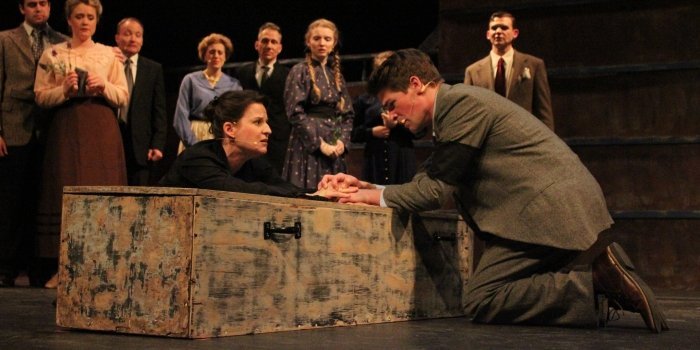Parade is an odd little musical, and not just because of its depressing subject matter. Fortunately, there are enough bright lights in the Fighting Chance production currently on stage to pull us out of its near perpetual darkness.
Parade is based on the true story of Leo Frank, a Jewish factory superintendent accused and found guilty of murdering a 13-year old girl employee in 1913 Atlanta. Fueled by an anti-Semitic press, community outrage ultimately led to a corrupt prosecution of Frank, with a verdict resulting in the death penalty. Discovering much of the testimony at trial was coerced, Frank’s sentence was commuted to life imprisonment. Seeking vigilante justice, a group kidnapped Frank from prison and lynched him.
While musical theatre has never shied away from the macabre or tragic, this Jason Robert Brown and Alfred Uhry penned creation is particularly bleak. But while its dark story may surprise some audiences, its biggest challenge lies in telling a story where the outcome is already pre-determined.
In already knowing Frank’s fate, the stakes are diminished. While act two provides some urgency as Frank’s wife works to exonerate him, we are still left with knowing the outcome. The obligation then boils down to telling the story effectively, and in its performances. Fortunately, there is much to like in both respects in this community theatre production.

This is a big production featuring a cast of 24. Coupled with its subject matter, this Parade screams out for a more traditional set-up. Director Ryan Mooney finds that in the Norman Rothstein Theatre located in Vancouver’s Jewish Community Centre.
Not only an appropriate venue because to its subject matter, Mooney uses it to full advantage, with plenty of room to move his large ensemble. Choreographer Adriana Ravalli also takes advantage of the space with some spot-on dance numbers.
There are also some significant meanings behind Tim Driscoll’s set design. The enormous wall upstage may be a bit on the nose, but it is a stark reminder of the rampant xenophobia which still exists today. The ever-present tree made from rope, and beautifully lit in white and reds by lighting designer Randy Charlston, is a constant a reminder of Frank’s fate. The four nooses growing from the tree are additional reminders of the other suspects in the murder.
While symbolism may take centre stage, there a few knockout performances, starting with Riley Sandbeck who plays the unsympathetic public perception of Frank with skill. Paired with Advah Soudack as his wife, the two find the heart of this show. In the vocal department, they easily handle Brown’s diverse music.
Speaking of music, it remains one of the biggest surprises and most satisfying moments of Parade, with blues, gospel, and jazz all joining the more traditional musical theatre oeuvre. Even when the disparate styles are seemingly inharmonious to the action, they are absolute pleasures when performed by the likes of Ricardo Cunha Pequenino and Sean Anthony.
Tucked somewhere in the wings, musical director Clare Wyatt gets the most of her small four-piece band.
While Parade was written nearly twenty years ago about events which took place over a hundred, it still has plenty to say today. As sad an indictment as Parade itself.
Parade with book by Alfred Uhry and music & lyrics by Jason Robert Brown. Co-conceived and directed on Broadway by Harold Prince. Vancouver production directed by Ryan Mooney. On stage at the Norman Rothstein Theatre (950 West 41st Ave, Vancouver) until April 29. Visit https://fightingchanceproductions.ca for tickets and information.

